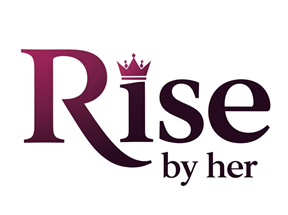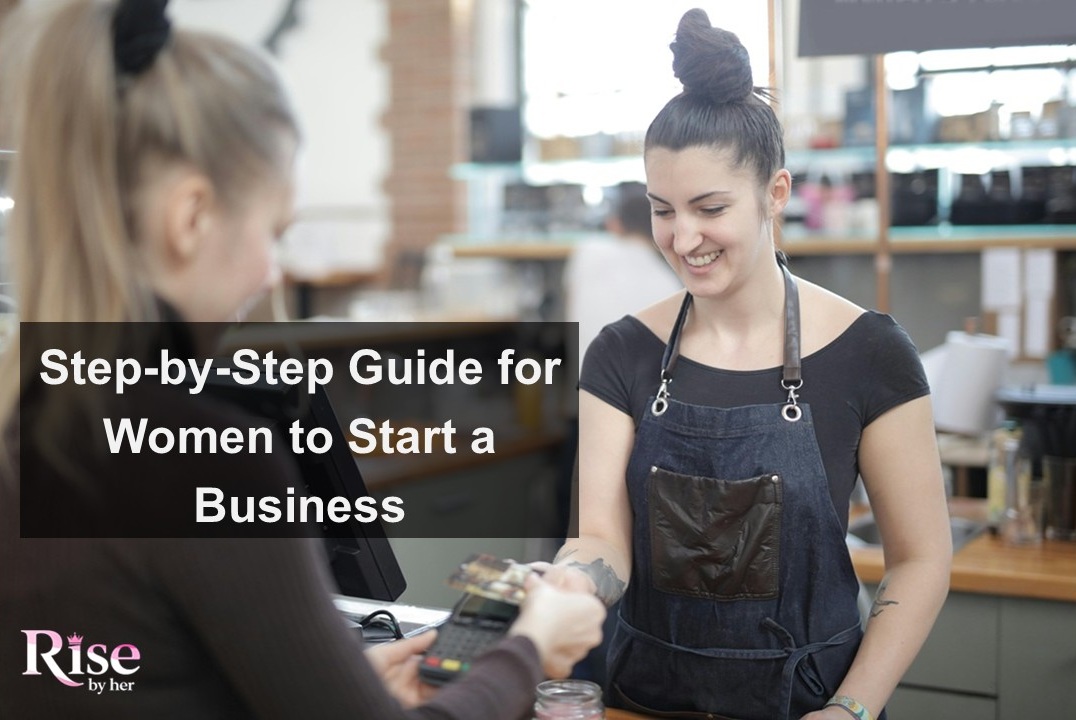In 2025, women entrepreneurs are shaping the future of business like never before. With access to digital tools, funding opportunities, and supportive networks, more women are breaking barriers and launching successful ventures across various industries. However, challenges like securing capital, balancing responsibilities, and navigating competitive markets remain key concerns.
This guide provides step-by-step strategies tailored to help aspiring female business owners start, grow, and sustain their businesses in 2025. Whether you’re exploring business ideas, funding options, or digital marketing strategies, this article will equip you with the insights and resources needed to turn your vision into reality.
Ready to take the first step? Let’s dive in!
Identifying Your Business Idea and Market Niche
Choosing the right business idea is the foundation of a successful venture. In 2025, women entrepreneurs have vast opportunities across profitable niches like e-commerce, digital services, coaching, and sustainable products.
How to Find a Winning Business Idea
- Assess Your Strengths & Passions: What skills or experiences can you turn into a business?
- Research Market Demand: Use tools like Google Trends, Ubersuggest, and AnswerThePublic to identify trending business ideas for women.
- Analyze Competitors: Study successful businesses in your niche to find gaps and opportunities.
- Validate Your Idea: Test with surveys, social media engagement, or a small pilot launch before committing fully.
Trending Business Niches for Women in 2025
- Digital products (e-books, courses)
- Eco-friendly brands (sustainable fashion, beauty)
- Remote services (virtual assistance, consulting)
- Health & wellness (coaching, fitness apps)
Key Takeaway: Align your business idea with both personal passion and market demand for long-term success.
Developing a Solid Business Plan
A well-structured business plan is crucial for turning your idea into a successful venture. It helps you clarify your vision, attract investors, and stay on track.
Key Components of a Business Plan
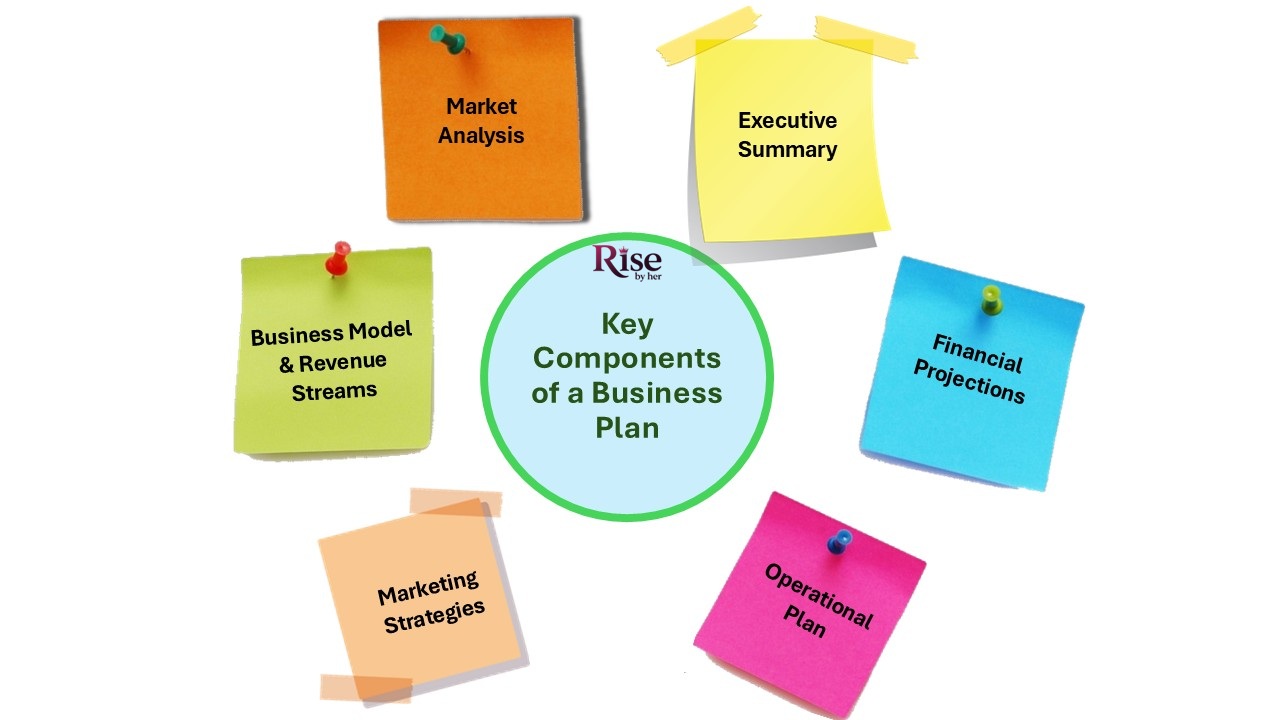
- Executive Summary: A concise overview of your business, mission, and unique value proposition.
- Market Analysis: Research your target audience, industry trends, and competitors to identify opportunities.
- Business Model & Revenue Streams: Define how you will generate income (e.g., product sales, subscriptions, services).
- Marketing Strategies: Outline branding, digital marketing, and customer acquisition tactics.
- Operational Plan: Detail daily operations, supply chain management, and team roles.
- Financial Projections: Estimate startup costs, pricing strategies, and break-even points.
Free Tools & Resources for Business Planning
- LivePlan: AI-powered business plan builder
- Score.org Templates: Free business plan templates
- Google Docs/Excel: DIY business plan tracking
Pro Tip: Keep your business plan flexible and revisit it regularly as your startup grows.
Understanding Legal Structures and Compliance
Choosing the right business legal structure is essential for protecting your assets, minimizing taxes, and ensuring compliance with regulations.
Types of Business Structures
- Sole Proprietorship: Simple setup, full control, but personal liability.
- Limited Liability Company (LLC): Combines liability protection with tax flexibility.
- Corporation (C-Corp & S-Corp): Best for scaling but involves more regulations.
- Partnership: Ideal for co-owned businesses, but partners share liability.
Key Legal Steps to Register Your Business
- Choose a Business Name: Ensure it is unique and available for registration.
- Register with the Government: File with local/state agencies and get a business license.
- Obtain an EIN (Employer Identification Number): Required for tax purposes and hiring employees.
- Open a Business Bank Account: Keep personal and business finances separate.
- Understand Tax & Licensing Requirements: Check local, state, and federal regulations.
Free Resources for Legal Compliance
- IRS.gov: Get EIN & tax compliance guides
- SBA.gov: Business structure & licensing help
- LegalZoom & Rocket Lawyer: Affordable legal assistance
Pro Tip: Consult a legal expert to choose the best structure for your business growth!
Securing Financing and Funding Opportunities for Women Entrepreneurs
Securing funding for your business is one of the most critical steps in launching a successful startup. In 2025, women entrepreneurs have more options than ever to access the financial resources needed to grow their businesses. Let’s explore the key funding options for women entrepreneurs.
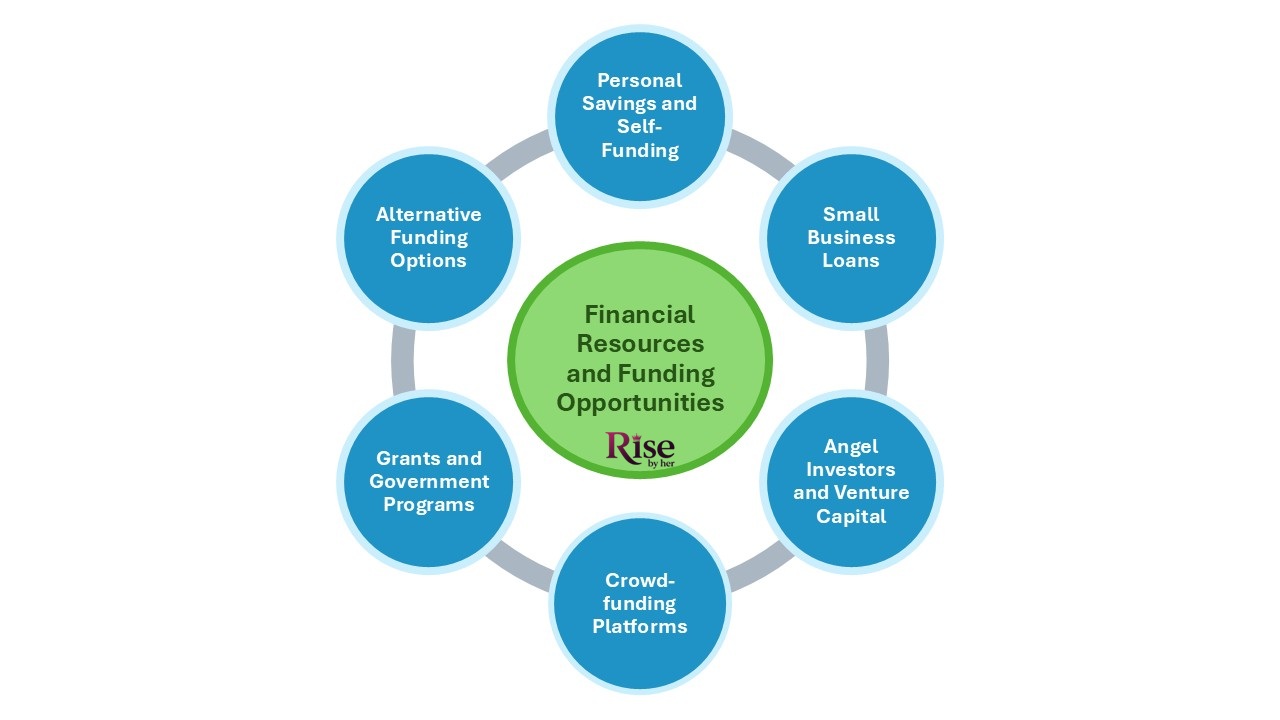
Personal Savings and Self-Funding
Using your own savings to finance your business offers control and avoids debt. However, it’s important to carefully manage your finances and ensure you can sustain your personal financial security.
Small Business Loans
Small business loans can provide significant capital for startups. Look into options such as:
- SBA Loans – Low-interest, government-backed loans ideal for new businesses.
- Microloans – Smaller loans, perfect for businesses just starting out.
Angel Investors and Venture Capital
Angel investors can be a game-changer, providing funding in exchange for equity or debt. These investors often bring valuable mentorship and networking opportunities. Key platforms to connect with angel investors:
- AngelList
- Golden Seeds
- 37 Angels
- Explore more Angel Investors
Crowdfunding Platforms
Crowdfunding allows you to raise money by appealing to a large group of people. Some popular platforms include:
- Kickstarter: For product-based startups.
- IFundWomen: Focused on supporting women entrepreneurs.
- Indiegogo: Great for tech-focused businesses.
- Explore more about Crowdfunding
Grants and Government Programs
Several grant programs are designed to help women entrepreneurs succeed, including:
- Amber Grant – $10,000 monthly grants, plus an annual $25,000 grant.
- Cartier Women’s Initiative – Funding and mentorship for women-led businesses.
- Explore more about Small Business Grants
Alternative Funding Options
Consider peer-to-peer lending or microloans. Websites like Kiva and Accion offer alternative financing options with lower interest rates.
Read the following article How Women Entrepreneurs Can Get Funding: Top Strategies for Success
Pro Tip: Leverage networks and online platforms to find the best investors and funding options that fit your business model.
With the right mix of funding options and resources, you can set your business up for long-term success.
Building a Support Network and Mentorship for Women Entrepreneurs
As a woman entrepreneur, building a strong support network and seeking mentorship are crucial for overcoming challenges and accelerating business growth. Surrounding yourself with the right people and resources can provide guidance, encouragement, and opportunities that will help you navigate the complexities of entrepreneurship.
The Power of Networking
Networking is essential for any entrepreneur, but especially for women in business. By connecting with other like-minded women, you can gain valuable insights, share experiences, and collaborate on opportunities. Consider joining women’s business networks like:
- National Association of Women Business Owners (NAWBO)
- Ellevate Network: A global community of women professionals supporting each other’s growth.
- Ladies Who Launch: An organization empowering women entrepreneur through events, resources, and networking.
These organizations not only provide a platform for meeting potential partners or investors but also create a sense of belonging and support within the entrepreneurial community.
Mentorship Programs
Finding the right mentor can significantly impact the trajectory of your business. A mentor can offer advice on decision-making, share industry knowledge, and help you avoid common pitfalls. Seek out mentorship programs specifically designed for women entrepreneurs, such as:
- Women’s Business Centers (WBCs): Offers free mentorship and resources to women-owned businesses.
- SCORE Mentorship Program: Provides free, confidential business mentoring with experienced business owners.
- The Young Women Entrepreneurs Network (YWEN): Offers mentorship and resources for young women looking to start and grow businesses.
Online Communities and Social Media Groups
In addition to formal networks, online communities and social media groups can serve as a valuable source of support and connection. Platforms like LinkedIn and Facebook have numerous groups where women entrepreneurs share advice, ask questions, and connect for potential collaborations. Some groups to explore include:
- Women Entrepreneurs of Facebook: A community of women sharing advice, experiences, and opportunities.
- SheEO: A global community of women entrepreneurs and investors supporting women-led ventures.
Attend Women-Focused Business Events
Participating in women-focused business events can help you expand your network, gain inspiration, and access growth opportunities. Consider attending events like:
- The Women’s Business Summit
- Forbes Women’s Summit
- Women in Business Conference: Tailored for entrepreneurs and executives to network and learn from industry leaders.
Peer Support and Accountability Groups
In addition to finding mentors, peer support is crucial. Consider joining or forming a peer accountability group, where you can exchange ideas, set goals, and hold each other accountable for progress. This peer-driven support system can be incredibly motivating and help you stay focused on your business growth.
By building a solid support network and seeking out mentorship, you’ll equip yourself with the tools, advice, and confidence needed to overcome challenges and accelerate your growth as a woman entrepreneur.
Marketing and Branding Strategies for Women Entrepreneurs
In the competitive world of entrepreneurship, developing a strong brand identity and implementing effective digital marketing strategies are key to standing out and attracting your ideal customers. A well-crafted brand, coupled with smart marketing tactics, can help elevate your startup and ensure its long-term success.
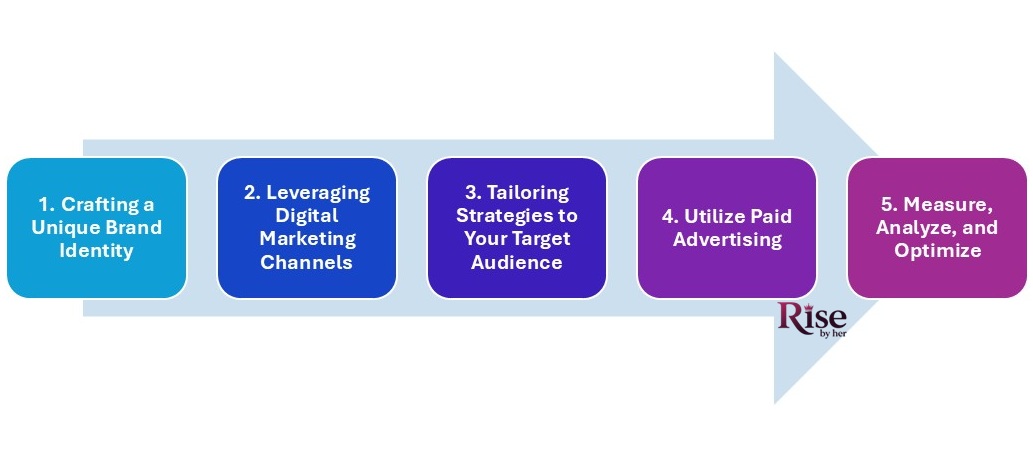
Crafting a Unique Brand Identity
Your brand identity is more than just a logo—it’s the essence of your business. A strong brand reflects your values, mission, and the unique value you bring to the market. To create a compelling brand for your startup, start by defining your business’s core message and target audience.
- Brand Vision and Mission: Your vision should convey your long-term aspirations, while your mission focuses on the purpose and values behind your business. For example, if you’re a sustainable fashion brand, your mission could be to promote eco-friendly products while offering stylish solutions for modern women.
- Brand Voice: The tone and personality of your brand play a significant role in connecting with your audience. Whether it’s professional, friendly, or innovative, consistency in communication is crucial.
- Visual Identity: Design elements like colors, fonts, and logo should align with the essence of your brand. Platforms like Canva and Looka are excellent tools for DIY branding.
Leveraging Digital Marketing Channels
In 2025, digital marketing is a must-have for any startup. To effectively reach and engage your target audience, take advantage of various digital marketing strategies:
- Social Media Marketing: Platforms like Instagram, Facebook, and LinkedIn are invaluable for promoting your brand. Choose platforms that align with where your target audience spends their time. Post regular, engaging content like behind-the-scenes looks, product launches, and user-generated content to create a personal connection.
- Content Marketing: Creating valuable content that addresses your audience’s pain points can position you as an authority in your niche. Whether it’s blog posts, infographics, or videos, content marketing helps build trust and encourages organic traffic to your website. Use SEO strategies to optimize your content and make it discoverable.
- Email Marketing: Building an email list is crucial for direct communication with your audience. Use email campaigns to keep your customers updated about new products, promotions, or important news. Platforms like Mailchimp or ConvertKit make it easy to design professional-looking emails and track performance.
Tailoring Strategies to Your Target Audience
Understanding your target audience’s behaviors, preferences, and challenges is essential when crafting marketing strategies. Conduct customer research through surveys, focus groups, or social media interactions to gather insights. Once you know your audience, personalize your marketing campaigns to resonate with them.
- Demographics and Psychographics: Consider factors such as age, income, location, and lifestyle when designing your brand message and campaigns.
- Customer Journey Mapping: Develop content and promotions based on where your customers are on their buying journey. For instance, create awareness-building content for new prospects and nurturing emails for leads who have shown interest.
Utilize Paid Advertising
While organic strategies are crucial, leveraging paid advertising can accelerate your brand’s reach. Platforms like Google Ads, Facebook Ads, and Instagram Ads allow you to target specific demographics, locations, and interests, making them ideal for small businesses looking to scale quickly.
- Retargeting: Use retargeting ads to engage visitors who have interacted with your brand before but didn’t convert. This can lead to higher conversion rates.
- A/B Testing: Test different ad variations to understand what resonates with your audience the most and optimize your ad performance.
Measure, Analyze, and Optimize
No marketing strategy is complete without data analysis. Use tools like Google Analytics, Facebook Insights, and email campaign reports to track key metrics such as website traffic, engagement, and conversion rates. Regularly assess your efforts to identify what’s working and adjust as needed.
By branding your startup effectively and leveraging the right digital marketing strategies, you can establish a unique presence in the market, attract your ideal customers, and set the foundation for long-term growth.
Leveraging Technology and Digital Tools
Essential Business Tools for Women Entrepreneurs
- Project Management: Trello, Asana, and Notion help organize tasks, track progress, and collaborate efficiently.
- Communication: Slack, Zoom, and Microsoft Teams enhance remote work and team coordination.
- Finance & Accounting: QuickBooks, Wave, and FreshBooks simplify bookkeeping, invoicing, and tax management.
- E-commerce & Sales: Shopify, Etsy, and WooCommerce provide platforms for selling products and services online.
Automate & Streamline Business Operations
- Marketing & Email Automation: Mailchimp and ConvertKit help automate email campaigns and nurture customer relationships.
- Social Media Management: Buffer and Hootsuite schedule posts and track engagement across multiple platforms.
- Customer Support & Chatbots: Chatfuel and Tidio offer AI-powered chatbots to improve customer interactions.
Cybersecurity & AI for Business Growth
- Security & Data Protection: LastPass secures passwords, while Cloudflare protects websites from cyber threats.
- AI Tools for Productivity:
- ChatGPT for content creation & customer engagement.
- Canva for branding & social media graphics.
- HubSpot for CRM & customer management.
Using the right tech tools boosts efficiency, reduces workload, and helps businesses scale faster in 2025.
Overcoming Challenges Unique to Women Entrepreneurs
Gender Bias in Entrepreneurship & How to Navigate It
- Women often face skepticism from investors and clients. Build credibility through a strong business plan, proven traction, and industry expertise.
- Join women-focused investment groups (e.g., Golden Seeds, Female Founders Fund) for better funding opportunities.
Limited Access to Funding & Financial Resources
- Apply for women-specific grants & loans (e.g., Amber Grant, IFundWomen, Cartier Women’s Initiative).
- Leverage alternative funding sources like crowdfunding, angel investors, and microloans.
Work-Life Balance & Managing Multiple Roles
- Time management & delegation: Use productivity tools like Trello, Notion, and Google Calendar.
- Outsource tasks when possible (e.g., hiring freelancers for admin work via Upwork or Fiverr).
Building Confidence & a Strong Network
- Join women-led business networks like NAWBO, Ellevate Network, and Lean In Circles for mentorship & support.
- Seek mentorship from experienced entrepreneurs to navigate challenges and accelerate growth.
Turning Challenges Into Opportunities
By embracing strategic planning, leveraging resources, and fostering a strong support network, women entrepreneurs can overcome barriers and build thriving, sustainable businesses in 2025.
Conclusion
Starting a successful business as a woman in 2025 is more achievable than ever. By choosing the right business idea, crafting a solid plan, securing funding, and leveraging technology and mentorship, you can build a thriving venture.
While challenges like gender bias and funding barriers exist, they can be overcome with strategic planning, networking, and access to the right resources. Act today, refine your business plan, connect with mentors, and explore funding opportunities.
What’s your biggest challenge in starting a business? Drop a comment below. I’d love to help!

